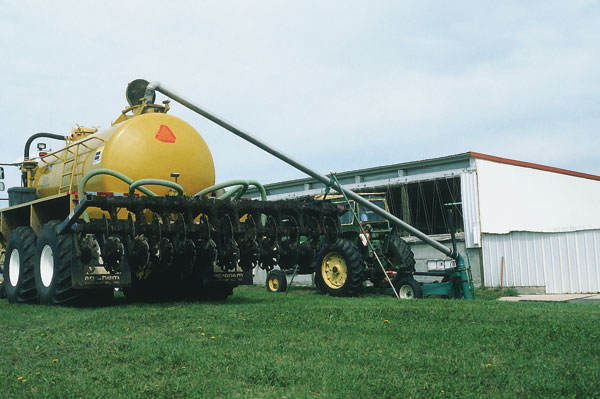Researchers from several Mid­western universities have teamed up to investigate potential causes and, hopefully, solutions, to the perplexing and dangerous problem of foaming manure pits under swine buildings.

Researchers from several Midwestern universities have teamed up to investigate potential causes and, hopefully, solutions, to the perplexing and dangerous problem of foaming manure pits under swine buildings.
A University of Minnesota producer survey found 25% of the Midwestern producers surveyed had experienced some foaming manure pits in their operations. The methane-containing foam is hazardous, and several hog buildings have exploded when sparks ignited methane released during pumping.
Because the foaming problem is so widespread and dangerous, the Iowa Pork Producers Association is contributing $1 million over three years to fund research involving Iowa State University (ISU), University of Illinois, University of Minnesota (U of M) and University of Nebraska. ISU’s Steve Hoff, professor of agricultural and biosystems engineering, is coordinating the multi-state research project.
“We are trying to uncover the root cause of the foaming manure problem. Once we know the root cause, we will look into the science behind how we can work to change the biological activity in the manure pit to keep the problem from occurring,” he explains. “It is important for pork producers to know that this large research effort is going to look at this problem from the ground up.” Research will officially begin in July 2012.
There are very strict stipulations that any potential solution that might be tested in manure pits as part of the research efforts must be first proven to work in the laboratory.
Microbial Analysis
University of Minnesota researchers have conducted laboratory studies to gain a better understanding of what is causing the pit foaming problem. Bo Hu is currently conducting a microbial analysis of the bacteria that may be responsible for the foaming response. Early indications point to a filamentous bacteria as the culprit, but ongoing research is aimed at understanding why the microbes react differently in foaming pits vs. non-foaming manure storage environments. When more is known about the specific bacteria, steps can be taken to control its growth.
In the meantime, as a short-term solution, preliminary research from Minnesota indicates pit foam may be reduced by adding monensin sodium (Rumensin 90 premix from Elanco Animal Health) directly to the manure pit. Rumensin is typically fed to beef cattle to reduce methane production in the rumen and, thus, increase their performance.
Chuck Clanton, professor in the Department of Bioproducts and Biosystems Engineering at the University of Minnesota, has tested Rumensin 90 premix and a similar product called Bloat Guard (Phibro Animal Health). Bloat Guard was ineffective in reducing foam at the levels added to the pit, he notes.
The research was conducted with five different producer groups across Minnesota. Each producer group had four similar manure pits receiving treatment — 20 pits in all. All but one set of the pits was experiencing foam. The non-foaming pits were used as a control group. Clanton says most of the pits had around 2 ft. of foam, but some had twice that amount.
Each set of four pits was randomized and the volume of manure was determined for each pit. Rumensin 90 was added at rates of 0, 2.5 lb., 5 lb. or 10 lb. per 100,000 gal. of manure. The product was sprinkled through the slats and into the pit. Clanton then compared the outcomes to untreated control sites at three-week and six-week intervals.
Adding Rumensin 90 in a concentrated form, 5 lb./100,000 gal. of manure, seemed to have the most impact on reducing foam.
“It can take up to 10-14 days to see a response, depending upon how thick the foam is,” Clanton explains. One key to success is to get the Rumensin 90 on the surface of manure as uniformly as possible. “Our recommendation is to sprinkle it between the slats, slowly and carefully, when the building is empty during the all-out phase of all-in, all-out production,” Clanton says. The Rumensin should be added to the manure pit before the building is washed, he emphasizes.
There are safety issues for both people and pigs when using Rumensin. The product can cause eye burns, allergic skin reactions and respiratory tract irritation and would be harmful if swallowed. If pigs consume enough of the product, it would be lethal, Clanton points out. Rumensin 90 can be purchased without a veterinarian’s approval.
“The research has shown Rumensin 90 works for up to six weeks and producer testimony indicates a lasting effect of several months,” Clanton says.
Additional research will study the effectiveness of adding Rumensin as a short-term solution, as well as the environmental implications of adding the product to manure when it is land-applied as a crop nutrient.
“Using Rumensin 90 to reduce foam is just a band-aid approach. We’re still scratching our heads when it comes to the cause of the foam in the first place,” Clanton reflects. “At this point in time, our main focus is on the species of bacteria that is actually causing the foam.”
He advises producers to routinely monitor manure pits. “We’re really trying to find out what the trigger mechanism is because there seems to be a very fine trigger point when the foam sets in.”
The Rumensin 90 research project was funded by the Minnesota Pork Board and the University of Minnesota Agricultural Experiment Station Rapid Response fund.
— Lora Berg is a freelance writer from Lakeville, MN.
About the Author(s)
You May Also Like



